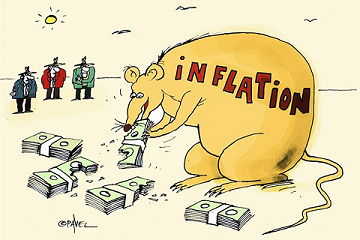
NEWS FLASH: Experts say there is no inflation – unless you eat, rent or own your home, or seek medical care.
The U.S. government claims that there is no increase in prices, except for things that consumers are buying. That sounds like something Keynesian goddess Paul Krugman would write in one of his famous dear diary entries in The New York Times.
The Bureau of Labor Statistics (BLS) recently announced that the consumer price index (CPI) tumbled 0.1% in May, thanks to declines in gasoline, apparel, and automobile insurance. The core rate of inflation, which eliminates energy and food prices, also dipped 0.1%. Put simply, essential items, especially in the middle of a public health crisis, are getting more expensive.
In May, supermarket prices climbed 1% from April. During the previous three months, grocery prices surged 4.1% – an annual rate of about 18%. Meat prices have also skyrocketed, including beef, which has spiked 11% since March. Residential costs – ownership and rental – rose at an annualized rate of 2.6%. This may not seem like much, but when housing can account for nearly half of a family’s income, the slightest jump can have a substantial impact.
Officials claim that we’re living in a time of deflation. But this is only true for frivolous products, like apparel and hotels, and if the COVID-19 lockdown has not impacted your bank account. And there lies the problem with government statistics – they are disconnected from the realities of Main Street.
From an Austrian School of Economics standpoint, the way the world talks about inflation is just as befuddling. We often view inflation as a boost in prices, but it really is an increase in the money supply, which depreciates the purchasing power of the currency. The fallout from this Keynesian directive is higher prices. With trillions of dollars being pumped into the system in such a short amount of time, price inflation for the stuff we need is going to be immense on the other side of the shutdown.
It is no secret that the entire country, from corporations to Uncle Sam to households, has had a love affair with debt since the 1980s. Thanks to interest rates trending lower over the last four decades, everyone has been gorging on red ink with reckless abandon. For some reason, every time you think the chickens have come home to roost, they never arrive. Will America’s luck ever run out? As Lefty Gomez, a famous MLB pitcher, once said, “I’d rather be lucky than good.”
According to the Federal Reserve’s frightening data about the state of the Union’s finances, debt has skyrocketed and household net worth declined. According to the U.S. central bank, total domestic non-financial debt spiked 11.7% to $55.9 trillion in the first three months of 2020. Despite the federal government spending trillions that lifted the national debt to above $26 trillion, Corporate America led the debt binge at 18%, while government debt followed closely at 14.3; and household, which paled in comparison stood at 1.5%.
Equity values dropped by $7.8 trillion as real estate values surprisingly jumped $400 billion in the January-March period. Because the stock market reclaimed much of its gains since bottoming out on March 23, the Fed’s second-quarter reading of the nation’s debt situation will likely show a considerable improvement.
Last year, Liberty Nation reported on a study that found if borrowing were outlawed, the nation’s gross domestic product (GDP) would collapse almost instantly. But this fixation with debt is not only concentrated in the U.S. – it is an international phenomenon, much like the Australian children’s musical group: The Wiggles. Too Much of it will give you a brain hemorrhage.
June 11 was déjà vu all over again as the stock market suffered its steepest one-day drop since March. The Dow Jones Industrial Average shed 1,800 points, the S&P 500 tumbled 5.89%, the Nasdaq Composite Index plummeted 5.27%, and crude oil prices slipped below $35. What was the cause? The primary factor was the Federal Reserve.
Despite triggering an unprecedented unlimited quantitative easing program and slashing rates to near zero, Wall Street was unhappy with Chair Jerome Powell’s mood after the June Federal Open Market Committee (FOMC) policy meeting. The Fed kept interest rates unchanged in the range of 0% to 0.25% and confirmed that it does not anticipate raising rates for two years. – got that savers – TWO YEARS!. They revised GDP estimate for the year downward to -6.5%, expecting the economy to rebound 5% next year.
Powell noted that the Fed plans to maintain credit flows and purchase Treasury and agency bonds during and after the pandemic. This seemingly did not make investors ebullient because it suggested the fundamentals of the economy are weak. And even though Powell did reassure reporters at a virtual press conference that the basics are solid, the Fed’s long-term projections have remained unchanged, as he urged Congress to adopt more fiscal relief and stimulus measures to support economic growth. More debt, really?
But the stock market is about as contradictory as Senator Mitt Romney’s (R-UT) political career. If Powell were to have said the inflationist intervention is coming to an end, it would have been bedlam on the New York Stock Exchange.
If the central bank were ever to tighten and take the training wheels off, the financial market would plummet. We have seen this situation unfold before. When the Fed was tightening by winding down its balance sheet and lifting interest rates gradually in 2017-2018, equities fell and could not survive on their own prompting the Fed to begin buying Treasuries, initiate a repurchasing program to ease the repo madness, and cut the benchmark rate prematurely – and this was before the Coronapocalypse!
Heaven help us!
Source: Swamponomics: There Is No Inflation If You Don’t Eat Or Sleep by Andrew Moran, Liberty Nation

